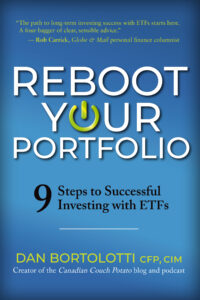Why the best investing move is usually…not to do anything
In the third of three excerpts from his new book, Reboot Your Portfolio, Dan Bortolotti argues that standing still is the best way to get ahead.
Advertisement
In the third of three excerpts from his new book, Reboot Your Portfolio, Dan Bortolotti argues that standing still is the best way to get ahead.

When you’re stuck in bumper-to-bumper traffic, do you constantly move from one lane to the other? We all do this, even though studies have demonstrated that it usually doesn’t get us where we’re going any faster. It just feels better to do something.
There’s a now-famous study in which researchers found that in soccer, goalkeepers almost always dive left or right when facing penalty kicks, even though they would stop more shots if they simply stood still. The study’s authors suggested an explanation for this behaviour: because the norm is to dive one way or the other, goalkeepers would feel worse if they surrendered a goal by staying in the centre of the net. The fans would probably feel the same way: “What’s he doing just standing there?”
These are examples of action bias: the tendency to resist doing nothing, even if an action is counterproductive. This bias is behind much of the criticism of buy-and-hold investors, especially indexers. It’s not hard to understand why. In almost everything we do—excelling at our jobs, learning a new language, getting in shape—it’s obvious the more time we spend on the activity, the better we perform. It goes against human intuition to accept that the opposite is usually true when it comes to investing. In most cases—assuming you begin with a sensible strategy—the more changes you make to your portfolio, the worse your performance will be.
Our action bias is especially acute during periods of economic turmoil: investors who stay the course are mocked for fiddling while Rome burns, yet they usually outperform more active traders over time. As the psychologist and Nobel laureate Daniel Kahneman writes in Thinking, Fast and Slow, “It’s clear that for the large majority of individual investors, taking a shower and doing nothing would have been a better policy than implementing the ideas that came to their minds.”
I would argue that investors who resist the urge to tinker with their portfolios are hardly guilty of inaction. Building a diversified portfolio with long-term targets—and rebalancing that portfolio, even when it’s emotionally difficult to do so—is the opposite of doing nothing. It’s executing a thoughtful and robust investment plan with discipline.

Investing shouldn’t be exciting. If you want excitement, pick another activity—maybe practicing yoga, or writing haiku or playing the ukulele.
Dan Bortolotti, CFP, CIM, is a portfolio manager with PWL Capital in Toronto. He works with clients to combine investment management with long-term financial planning. He also promotes investor education through his blog, articles and podcast.
This article was excerpted from Reboot Your Portfolio: 9 Steps to Successful Investing
Share this article Share on Facebook Share on Twitter Share on Linkedin Share on Reddit Share on Email
All very good points that accord with my own experience. In any event, when things seem to go south it’s never clear what to do… I prefer to think that I am galvanized into inaction!
good advice.